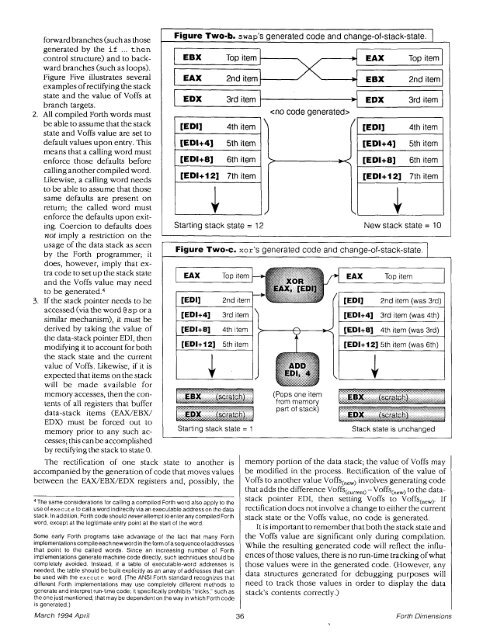FAST Forth Native-Language Embedded Computers
FAST Forth Native-Language Embedded Computers
FAST Forth Native-Language Embedded Computers
Create successful ePaper yourself
Turn your PDF publications into a flip-book with our unique Google optimized e-Paper software.
forward branches (such as those<br />
generated by the if ... then<br />
control structure) and to back-<br />
ward branches (such as loops).<br />
Figure Five illustrates several<br />
examples of rectifying the stack<br />
state and the value of Voffs at<br />
branch targets.<br />
2. All compiled <strong>Forth</strong> words must<br />
be able to assume that the stack<br />
state and Voffs value are set to<br />
default values upon entry. This<br />
means that a calling word must<br />
enforce those defaults before<br />
calling another compiled word.<br />
Likewise, a calling word needs<br />
to be able to assume that those<br />
same defaults are present on<br />
return; the called word must<br />
enforce the defaults upon exit-<br />
ing. Coercion to defaults does<br />
not imply a restriction on the<br />
usage of the data stack as seen<br />
by the <strong>Forth</strong> programmer; it<br />
does, however, imply that ex-<br />
tra code to set up the stack state<br />
and the Voffs value may need<br />
to be gen~rated.~<br />
3. If the stack pointer needs to be<br />
accessed (via the word @ sp or a<br />
similar mechanism), it must be<br />
derived by taking the value of<br />
the data-stack pointer EDI, then<br />
modifying it to account for both<br />
the stack state and the current<br />
value of Voffs. Likewise, if it is<br />
expected that items on the stack<br />
will be made available for<br />
memory accesses, then the con-<br />
tents of all registers that buffer<br />
data-stack items (EAX/EBX/<br />
EDX) must be forced out to<br />
memory prior to any such ac-<br />
cesses; this can be accomplished<br />
by rectifying the stack to state 0.<br />
Figure Two-b. swap's generated code and change-of-stack-state. 1<br />
EDX 3rd i tem ------------<br />
<br />
[ED11 4th item<br />
[ED1+4] 5th item<br />
[ED1+8] 6th item<br />
-<br />
[EDI+12] 7th item<br />
The rectification of one stack state to another is<br />
accompanied by the generation of code that moves values<br />
between the EAX/EBX/EDX registers and, possibly, the<br />
Top item<br />
Figure Two-c. xor's generated code and change-of-stack-state.<br />
2nd item<br />
EDX 3rd item<br />
Starting stack state = 1 Stack state is unchanged<br />
memory portion of the data stack; the value of Voffs may<br />
be modified in the process. Rectification of the value of<br />
Voffs to another value Voffs(,,,) involves generating code<br />
that adds the difference V~ffs(,,,,,~ -Voffs(,,,) to the datastack<br />
pointer EDI, then setting Voffs to Voffs(,,,). If<br />
rectification does not involve a change to either the Current<br />
4The same considerations for calling a compiled <strong>Forth</strong> word also apply to the<br />
use of execute to call a word indirectly via an executable addresson the data<br />
-<br />
stack. In add~tion, <strong>Forth</strong> code should neverattempt toenterany compiled <strong>Forth</strong> stack state or the Voffs value, no code is generated.<br />
word, except at the legitimate entry point at the start of the word.<br />
Some early <strong>Forth</strong> programs take advantage of the fact that many <strong>Forth</strong><br />
implementationscompileeachnewwordintheformofasequenceofaddresses<br />
that point to the called words. Since an increasing number of <strong>Forth</strong><br />
implementations generate machine code directly, such techniques should be<br />
completely avoided. Instead, if a table of executable-word addresses is<br />
needed, the table should be built explicitly as an array of addresses that can<br />
be used with the execute word. (The ANSI <strong>Forth</strong> standard recognizes that<br />
different <strong>Forth</strong> implementations mav use comoletelv different methods to<br />
March 1994 April<br />
. ,<br />
Starting stack state = 12<br />
generate and interpret run-time code'; it specifically prohibits "tricks," such as<br />
the one just mentioned, that may be dependent on the way in which <strong>Forth</strong> code<br />
is generated.)<br />
\<br />
><br />
,' \,<br />
It is important to remember that both the stack state and<br />
the Voffs value are significant only during compilation.<br />
while the resulting generated code will reflect the influenceS<br />
of those there is no run-time tracking of what<br />
those values were in the generated code. (However, any<br />
data structures generated for debugging purposes will<br />
need to track those values in order to disda~ the data<br />
stack's Contents correctly,)<br />
1<br />
[ED11 4th item<br />
[ED1+4] 5th item<br />
[ED1+8] 6th item<br />
[ED1+12] 7th item<br />
J. New stack state = 10<br />
<strong>Forth</strong> Dimensions
















